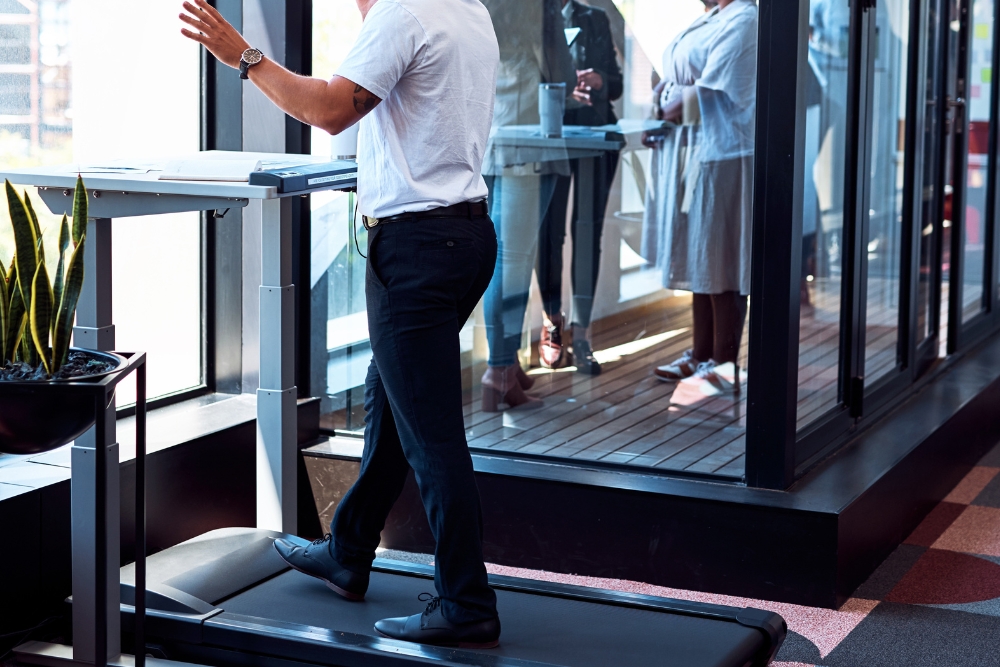Picture this: you often work from home, which means you can spend almost the entirety of your daylight hours in front of a screen without even the healthy reprieve of just leaving your house to make a trip to the office. But it’s all good, because while you’ve been typing away on your computer, you’ve been taking a stroll on your walking pad too.
Not only are you getting your work done, but you’re also clocking in your steps and burning a few calories without even feeling it. Go, multitasking!
But is that all there is to it?
The Walking Pad: A Game-Changer in the World of Office Wellness
Walking pads have been a rising star in the last few years, when COVID-19 lockdowns spurred people to find ways to keep active within the confines of their homes. Even now, it occasionally pops up on social media as an addition to a WFH-er’s work space.
And if you’re wondering exactly what it is, a walking pad is a lightweight, portable and cheaper version of home treadmills that you can slide under a table.
@hauskris Didn’t even walk half the work day and got in soooo many miles!! #walkingpad #treadmilldesk #standingdesk #wfh #wfhlife #wfhhacks #productivity #treadmill #workfromhome ♬ original sound – hauskris
Its main appeal comes in the fact that its very existence can combat the sedentary lifestyle often promoted by a desk job, as well as the consequences that come with such a lifestyle.
“While a brief period of sitting here and there is natural, sitting for long periods of time can seriously impact your health,” explained Dr Bernice Liu, a Principal Physiotherapist at the Department of Physiotherapy in Sengkang General Hospital, in HealthXchange.
As office workers, we’re all familiar with the neck and back aches that accompany a long day of sitting.
However, beyond just giving you dead butt syndrome, extensive periods of inactivity can go as far as increasing your risk of obesity, musculoskeletal disorders, and cardiovascular issues.
But with a walking pad, it feels like we can simply walk away from all these problems.
Benefits of Walking While You Work
The benefits of something as basic as walking are numerous: better blood circulation, better immunity, and even a better mental state.
Regular walking can reduce stress, promote focus, and improve work performance. Best of all, incorporating walking into your workday means you don’t need to carve out extra time for exercise, which can be a game-changer for those with busy schedules.
With all the advantages this little machine brings, they’re bound to outweigh any downsides to having one. Right?
Can We Fully Rely on Walking Pads for Activity and Productivity?
While owning a walking pad might seem like a no-brainer, it’s not for everyone.
For one, getting a walking pad means getting a standing desk, which can be a little expensive if you’re on a budget.
For another, results may vary, specifically in terms of focus.
Comment
byu/PenelopeSchwartz from discussion
inworkfromhome
While studies have shown that adding walks to a work environment can improve brain functioning and net work performance, it doesn’t necessarily translate to improved work productivity. For example, typing on a keyboard can become a little more challenging when you’re in constant motion. It’s hard to focus on tasks that require intense concentration while walking. For those people, walking sessions often get relegated to simpler tasks, like checking emails or attending meetings.
Walk Outs Are Not Workouts
For those of you who find working while walking to be no cognitive issue, here comes another caveat: it can’t fully replace cardio exercise.
Which means that yes, even during hectic periods, you have to squeeze in a proper workout somewhere.
Adults are recommended to have, at minimum, 150 minutes of moderate-intensity exercise a week, meaning we need to get our sweat going. While it’s possible to achieve this on walking pads that come with higher speed settings (some can get you on a light jog), we don’t normally power-walk our way through a work day. And if you have a fitness goal that involves losing weight or gaining musculature, walking won’t be enough.
Too Much of a Good Thing
Moreover, if you think you can compensate by making your walking pad sessions longer, that can be a dangerous path to tread. Although sitting all day can be unhealthy, walking for hours at a time isn’t safe either.
Walking too much when your body isn’t used to it can result in overuse injuries, including physical strain and joint stress. Taking breaks, sitting down to rest is important to prevent fatigue and avoid overtaxing your body.
All things considered, transplanting your chair with a walking pad can still be a good choice. After all, if owning one encourages you to be more physically active, then the investment is worth it for your health.
Know What You’re Getting Into With a Walking Pad
Before you get a walking pad, consider whether it can be a truly beneficial addition to your life. Just because it’s trending on TikTok, doesn’t necessarily mean it’s for you.
Comment
byu/nerdcorner from discussion
inproductivity
Enjoying a stroll outside, away from your screen and under a few rays of vitamin D, is still the better option for your overall wellbeing.
If you still decide to get a walking pad, start slow. Ease into it with short sessions, walking at a comfortable pace for about 30 minutes at a time.
Ultimately, the decision to incorporate a walking pad into your work routine is a personal one. If you use it consistently, it could prove to be a great tool for boosting both health and productivity. So, if you’re buying one – make sure you’re actually using it!

